engine CHEVROLET TRACKER 1995 User Guide
[x] Cancel search | Manufacturer: CHEVROLET, Model Year: 1995, Model line: TRACKER, Model: CHEVROLET TRACKER 1995Pages: 354, PDF Size: 18.24 MB
Page 60 of 354
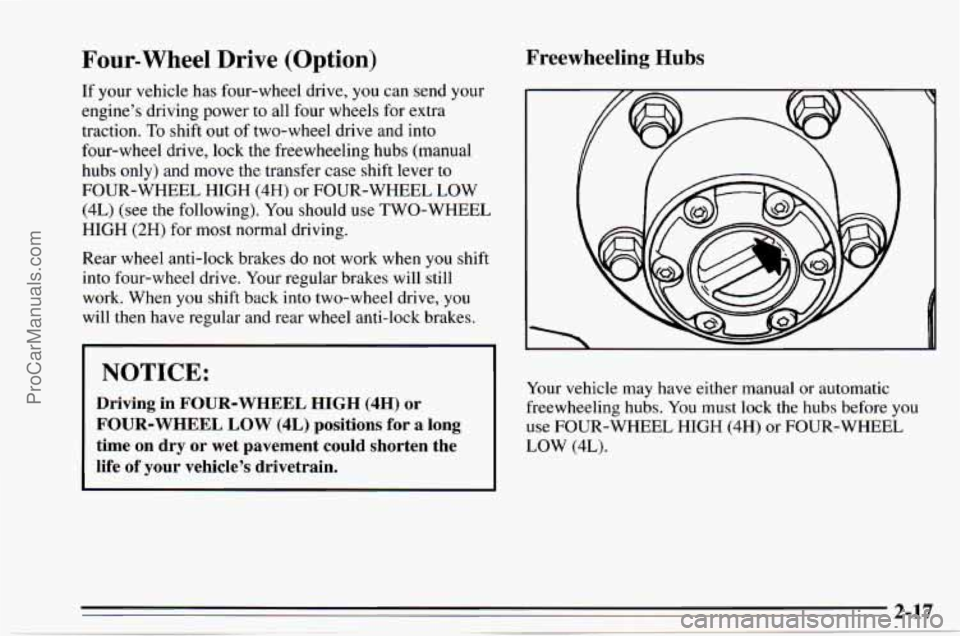
Four-wheel Drive (Option)
If your vehicle has four-wheel drive, you can send your
engine’s driving power to all four wheels for extra
traction.
To shift out of two-wheel drive and into
four-wheel drive, lock the freewheeling hubs (manual
hubs only) and move the transfer
case shift lever to
FOUR-WHEEL
HIGH (4H) or FOUR-WHEEL LOW
(4L) (see the following). You should use TWO-WHEEL
HIGH
(2H) for most normal driving.
Rear wheel anti-lock brakes
do not work when you shift
into four-wheel drive. Your regular brakes will still
work. When you shift back into two-wheel drive,
you
will then have regular and rear wheel anti-lock brakes.
NOTICE:
Driving in FOUR-WHEEL HIGH (4H) or
FOUR-WHEEL LOW (4L) positions for a long
time on dry or wet pavement could shorten the
life of your vehicle’s drivetrain.
Freewheeling Hubs
Your vehicle may have either manual or automatic
freewheeling hubs. You must
lock the hubs before you
use FOUR-WHEEL HIGH (4H) or FOUR-WHEEL
LOW (4L).
ProCarManuals.com
Page 65 of 354
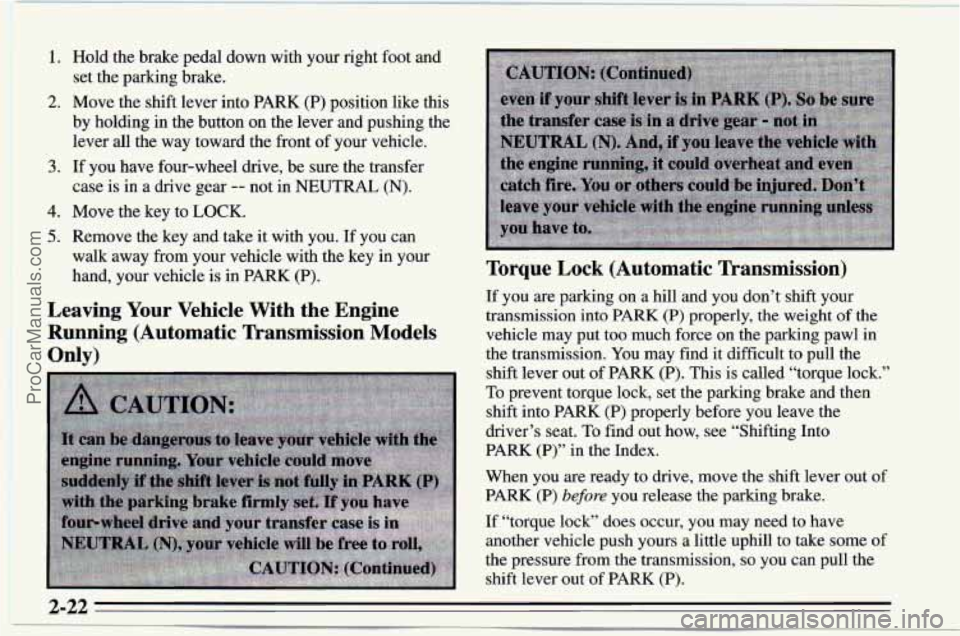
1.
2.
3.
4.
5.
Hold the brake pedal down with your right foot and
set the parking brake.
Move the shift lever into PARK
(P) position like this
by holding
in the button on the lever and pushing the
lever all the way toward the front of your vehicle.
If you have four-wheel drive, be sure the transfer
case is in a drive gear
-- not in NEUTRAL (N).
Move the key to LOCK.
Remove the key and take it with you. If you can
walk away
from your vehicle with the key in your
hand, your vehicle is in PARK (P).
Leaving Your Vehicle With the Engine
Running (Automatic Transmission Models
Only) Torque Lock (Automatic Transmission)
If you
are parking on a hill and you don’t shift your
transmission
into PARK (P) properly, the weight of the
vehicle may put too much force
on the parking pawl in
the transmission. You may find it difficult to pull the
shift lever out
of PARK (P). This is called “torque lock.”
To prevent torque lock, set the parking brake and then
shift into PARK (P) properly before you leave the
driver’s seat. To find out how, see “Shifting Into
PARK (P)” in the Index.
When you are ready to drive, move the shift lever out of
PARK (P)
before you release the parking brake.
If “torque lock” does occur, you may need to have
another vehicle push yours a little uphill to take some of
the pressure from the transmission,
so you can pull the
shift lever out of PARK
(P).
2-22
ProCarManuals.com
Page 66 of 354
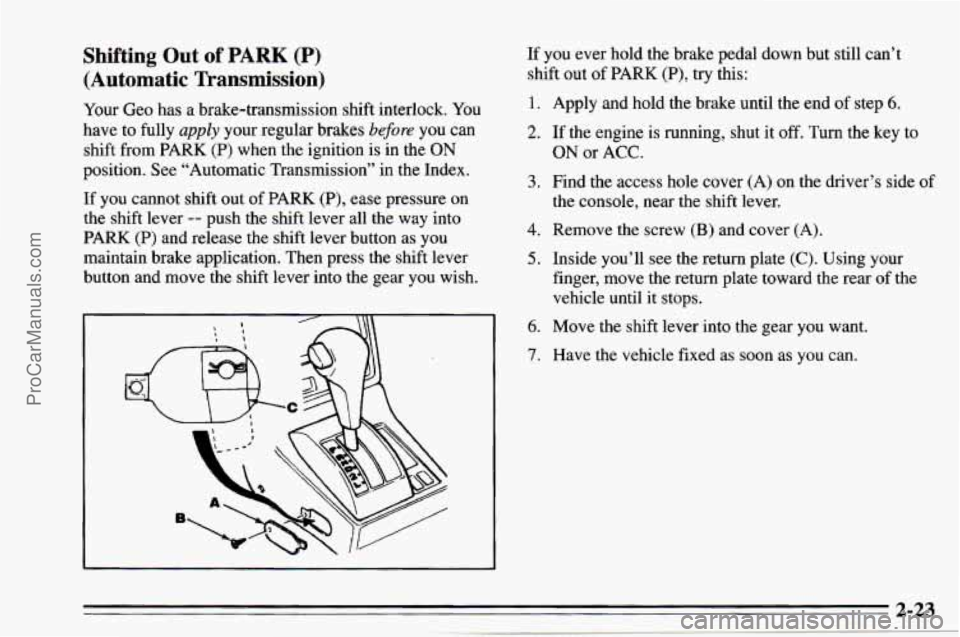
Shifting Out of PARK (P)
(Automatic Transmission)
Your Geo has a brake-transmission shift interlock. You
have to fully
apply your regular brakes before you can
shift from PARK
(P) when the ignition is in the ON
position. See “Automatic Transmission” in the Index.
If you cannot shift out of
PARK (P), ease pressure on
the shift lever -- push the shift lever all the way into
PARK
(P) and release the shift lever button as you
maintain brake application. Then press the shift lever
button and move the shift lever into the gear you wish. If
you ever hold the brake pedal down but still can’t
shift out of
PARK (P), try this:
1. Apply and hold the brake until the end of step 6.
2. If the engine is running, shut it off. Turn the key to
3. Find the access hole cover (A) on the driver’s side of
4. Remove the screw (B) and cover (A).
5. Inside you’ll see the return plate (C). Using your
ON or ACC.
the console, near the shift lever.
finger, move the return plate toward the rear of the
vehicle until it stops.
6. Move the shift lever into the gear you want.
7. Have the vehicle fixed as soon as you can.
2-23
ProCarManuals.com
Page 68 of 354
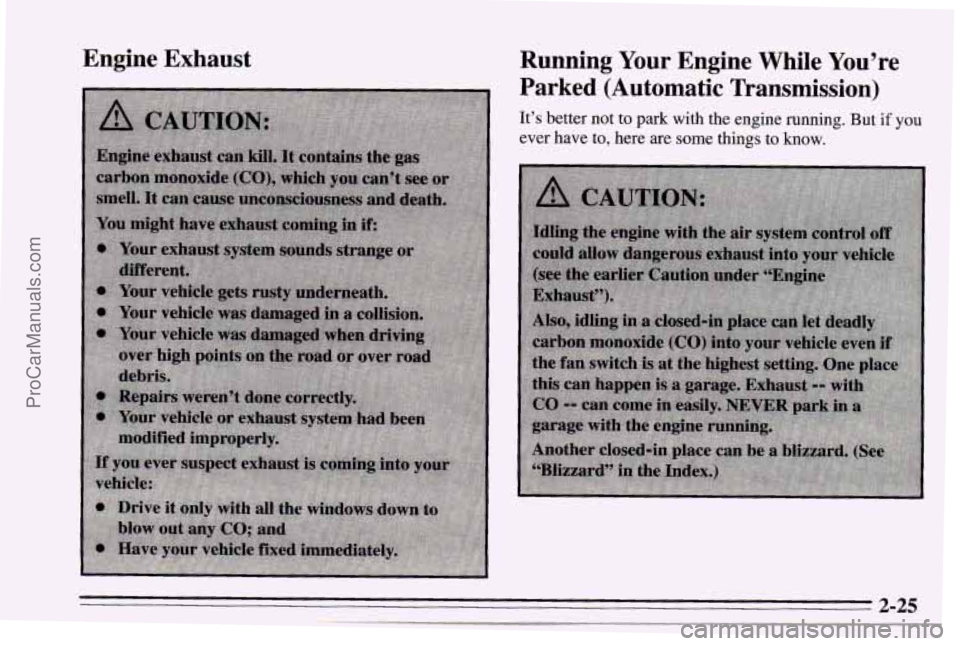
Engine Exhaust Running Your Engine While You’re
Parked (Automatic Transmission)
It’s better not to park with the engine running. But if vou
ever have to, here are some things to know.
2-25
ProCarManuals.com
Page 85 of 354
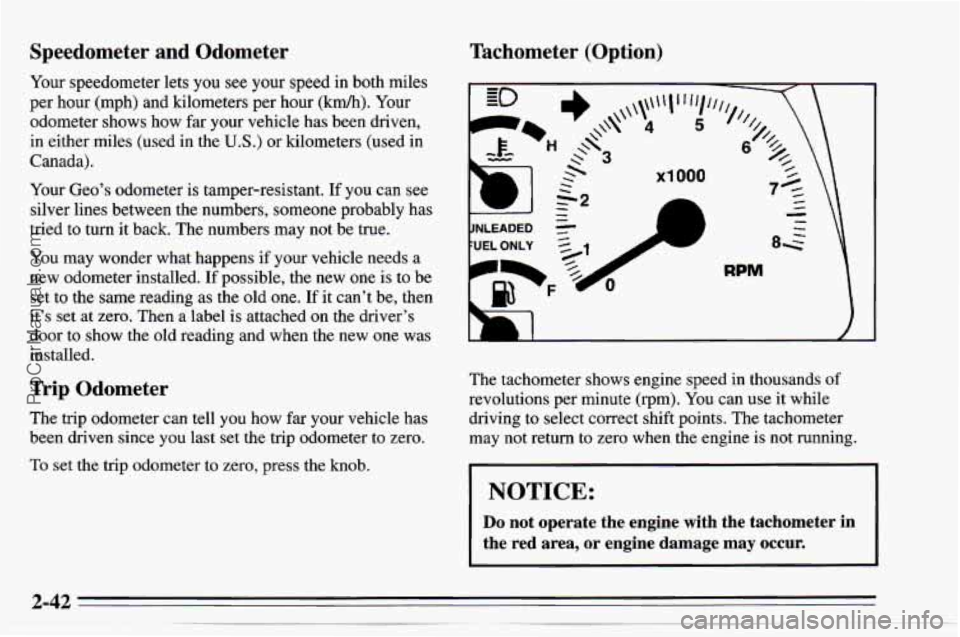
Speedometer and Odometer
Your speedometer lets you see your speed in both miles
per hour (mph) and kilometers per hour
(km/h). Your
odometer shows how
far your vehicle has been driven,
in either miles (used in the
U.S.) or kilometers (used in
Canada).
Your Geo’s odometer is tamper-resistant.
If you can see
silver lines between the numbers, someone probably has
tried to turn it back. The numbers may not be true.
You may wonder what happens if your vehicle needs a
new odometer installed. If possible, the new one is to be
set to the same reading
as the old one. If it can’t be, then
it’s set at zero. Then
a label is attached on the driver’s
door to show the old reading and when the new one was
installed.
Trip Odometer
The trip odometer can tell you how far your vehicle has
been driven since you last set the trip odometer to zero.
To set the trip odometer to zero, press the knob.
Tachometer (Option)
RPM
The tachometer shows engine speed in thousands of
revolutions per minute (rpm). You can use it while
driving to select correct shift points. The tachometer
may not return to zero when the engine is not running.
NOTICE:
Do not operate the engine with the tachometer in
the red area, or engine damage
may occur.
ProCarManuals.com
Page 86 of 354
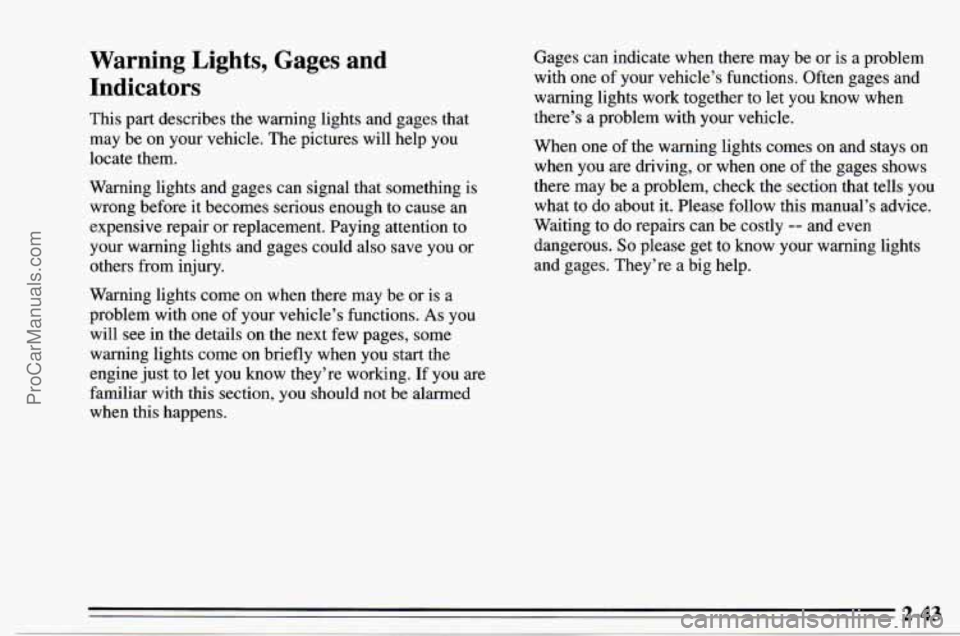
Warning Lights, Gages and Indicators
This part describes the warning lights and gages that
may be on your vehicle. The pictures will help you
locate them.
Warning lights and gages can signal that something is
wrong before it becomes serious enough to cause an
expensive repair or replacement. Paying attention to
your warning lights and gages could also save you or
others from injury.
Warning lights come on when there may be or is
a
problem with one of your vehicle’s functions. As you
will see in the details on the next few pages, some
warning lights come on briefly when you start the
engine just to let you know they’re working. If you are
familiar with this
section, you should not be alarmed
when this happens. Gages
can indicate when there may be or is a problem
with one of your vehicle’s functions. Often gages and
warning lights work together to let you
know when
there’s a problem with your vehicle.
When one of the warning lights comes on and stays on
when you are driving, or
when one of the gages shows
there may be a problem, check the section that tells you
what to do about it. Please follow this manual’s advice.
Waiting to do repairs can be costly
-- and even
dangerous.
So please get to know your warning lights
and gages. They’re a big help.
ProCarManuals.com
Page 87 of 354

Safety Belt Reminder Light
When the key is turned to
ON or START, a light will
come
on for about eight
seconds to remind people to
fasten their safety belts.
Unless the driver’s safety
belt
is already buckled, a
chime will also sound.
Charging System Light
This red light will come on
briefly when you turn on the
ignition, but the engine is
not running, as
a check to
show you it is working.
Then it should
go out when
the engine starts.
If the light stays on or comes on while you are driving,
you may have a problem with the electrical charging
system. It could indicate that you have
a loose generator
drive belt or another electrical problem. Have
it checked
right away. Driving while this light is
on could drain
your battery.
If you must drive a short distance with this light on, be
certain to turn
off all your accessories, such as the radio
and air conditioner.
ProCarManuals.com
Page 89 of 354
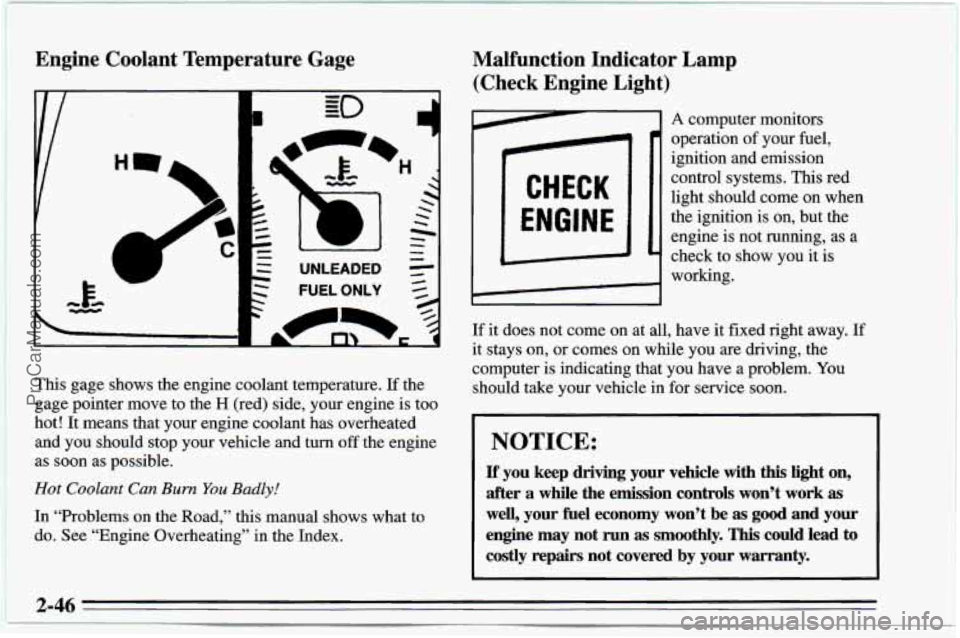
Engine Coolant Temperature Gage
This gage shows the engine coolant temperature. If the
gage pointer move to the
H (red) side, your engine is too
hot! It means that your engine coolant has overheated
and you should stop your vehicle and turn
off the engine
as soon as possible.
Hot Coolant Can Burn You Badly!
In “Problems on the Road,” this manual shows what to
do. See “Engine Overheating”
in the Index.
Malfunction Indicator Lamp
(Check Engine Light)
A computer monitors
operation
of your fuel,
ignition and emission
control systems. This red
light should come
on when
the ignition
is on, but the
engine
is not running, as a
check to show you it is
CHECK
ENGINE
Da i
I
If it does not come on at all, have it fixed right away. If
it stays on, or comes on while you are driving, the
computer is indicating that you have a problem. You
should take your vehicle in
for service soon.
NOTICE:
If’ you keep driving your vehicle with this light on,
after a while the emission controls won’t work
as
well, your fuel economy won’t be as good and your
engine may not
run as smoothly. This could lead to
costly repairs not covered by your warranty.
2-46
I
ProCarManuals.com
Page 90 of 354
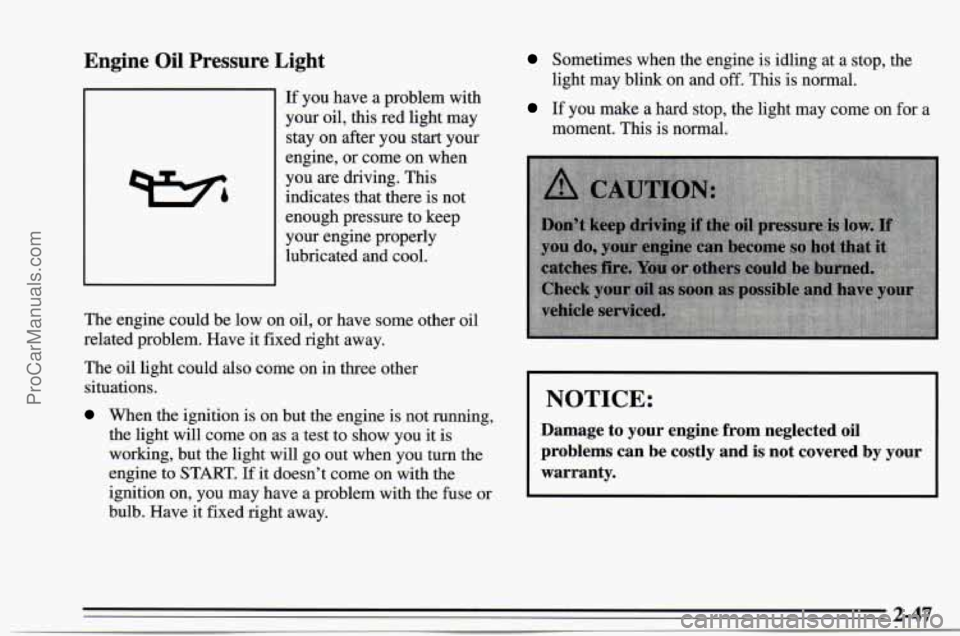
Engine Oil Pressure Light
If you have a problem with
your oil, this red light may
stay on after you start your
engine, or come on when
you are driving. This
indicates that there is not
enough pressure to keep
your engine properly
lubricated and cool.
The engine could be low on oil, or have some other oil
related problem. Have
it fixed right away.
The oil light could also come on in three other
situations.
When the ignition is on but the engine is not running,
the light will come on as a test to show you it is
working, but the light will go out when you turn the
engine to START.
If it doesn’t come on with the
ignition on, you may have a problem with the fuse
or
bulb. Have it fixed right away.
Sometimes when the engine is idling at a stop, the
If you make a hard stop, the light may come on for a
light
may blink on and
off. This is normal.
moment. This is normal.
I NOTICE:
Damage to your engine from neglected oil
problems can be costly and
is not covered by your
warranty.
ProCarManuals.com
Page 91 of 354
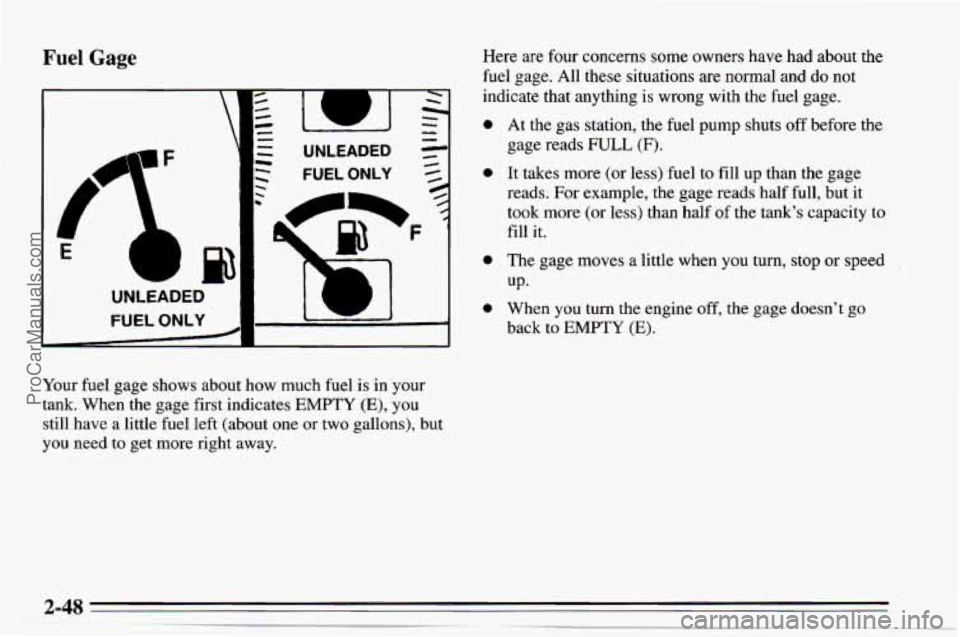
Fuel Gage Here are four concerns some owners have had about the
fuel gage. All these situations are normal and do not
indicate that anything is wrong with the fuel gage.
0
0
0
e
Your fuel gage shows about how much fuel is in your
tank. When the gage first indicates
EMPTY (E), you
still have a little fuel left (about one or two gallons), but
you need
to get more right away. At
the gas station, the fuel pump shuts off before the
gage reads
FULL (F).
It takes more (or less) fuel to fill up than the gage
reads. For example, the gage reads half full, but it
took more (or less) than half
of the tank’s capacity to
fill it.
The gage moves a little when you turn, stop or speed
UP-
When you turn the engine off, the gage doesn’t go
back to EMPTY (E).
ProCarManuals.com